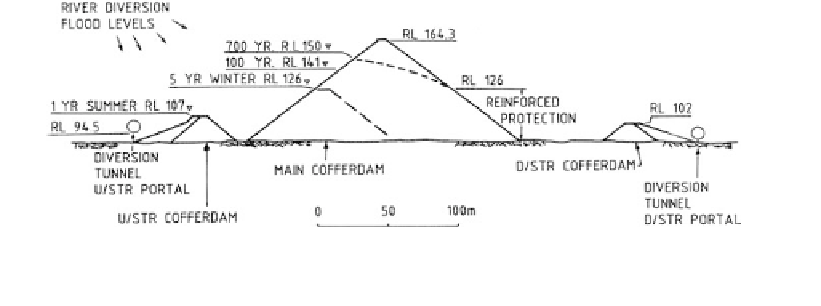Environmental Engineering Reference
In-Depth Information
If the soil is dispersive, it should be modified with lime or gypsum to render it non-
dispersive.
Compaction control should be as rigorous as for any dam and all conduits, culverts,
pipes and walls should be treated with a filter diaphragm as discussed in Section 13.5.
This should give a likelihood of piping failure less than that of overtopping.
The embankments are unlikely to reach the steady state seepage condition (or instanta-
neous drawdown), so slopes can be steeper than a normal dam. Hence from slope stabil-
ity considerations, embankments built of clay soils can stand at 1.5H to 1V. Silty sands, or
sandy soil embankments will, however, saturate quickly and require flatter slopes.
From the erosion control viewpoint, slopes of 3H to 1V or flatter are preferable and
this may override stability considerations.
The partial saturation effect may be more important for levee banks on the side of a
river if it can be shown that the levee will not saturate. However, care must be taken as
most levee bank failures occur on drawdown of the flood.
It should be recognised that use of such a cross section does have risks of failure higher
than for well designed dams. Where practical and warranted from a consequences of fail-
ure viewpoint, it would be better to use a zoned earthfill cross section, or earthfill with ver-
tical and horizontal drains.
For flood control structures in urban areas, the consequences of failure should be
assessed and the embankment section selected accordingly. Where there is a potential for
loss of life, the embankment should have proper internal erosion and seepage control.
13.8
DESIGN OF DAMS FOR OVERTOPPING DURING CONSTRUCTION
13.8.1
General design concepts
When embankment dams are constructed on a river it is necessary to divert the river from
the river bed during construction (of the dam or a culvert along the lower part of one of
the abutments). This is usually done by excavating a diversion tunnel through an abut-
ment of the dam and constructing a coffer dam upstream of the embankment to divert the
river into the diversion tunnel. This upstream coffer dam may be supplemented by a higher
coffer dam which is incorporated into the main embankment as shown in Figure 13.24.
When designing coffer dams a balance is reached between the height (and therefore
cost) of the coffer dam and the recurrence period of the flood which will overtop the dam.
Also important are the consequences of overtopping in potential damage to the construction
works, delay to construction schedules and potential for damage or loss of life downstream.
Of particular concern is the situation if the coffer dam fails, giving a substantial flood wave.
Figure 13.24.
Coffer dams for river diversion.


